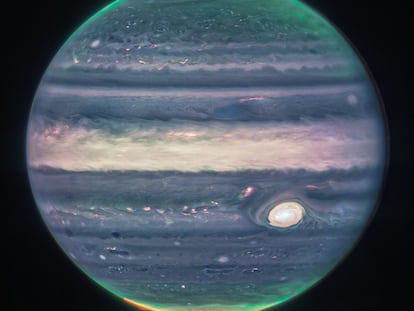Neptune as seen by the ‘James Webb’ super telescope: The sharpest image of its rings in 30 years
The NASA observatory offers a new view of the planet’s distinctive shape

The European Space Agency describes the James Webb Space Telescope’s new photographs of Neptune as the sharpest images of the icy giant in over 30 years. The largest astronomical observatory ever launched into space has taken clear pictures of the faintest bands of dust that surround the planet, which haven’t been seen with such clarity since the Voyager 2 probe captured them in 1989.
Usually seen as blue in color because of its hydrogen- and helium-rich composition, the solar system’s eighth planet appears quite dark in the new image because of the wavelengths detected by the Webb telescope’s infrared camera (NIRCam). For the first time, high-altitude cumulus clouds appear prominently in the satellite images; the clouds are bright because they reflect sunlight before the planet’s methane gas absorbs it.

The Webb telescope also captured images of Triton, one of Neptune’s 14 known moons. In the images, Triton appears the brightest of all because it consists of frozen nitrogen, which reflects 70% of the sunlight that reaches it.
German astronomer Johann Gottfried Galle discovered Neptune in 1846. The planet is located in one of the solar system’s darkest areas.
Tu suscripción se está usando en otro dispositivo
¿Quieres añadir otro usuario a tu suscripción?
Si continúas leyendo en este dispositivo, no se podrá leer en el otro.
FlechaTu suscripción se está usando en otro dispositivo y solo puedes acceder a EL PAÍS desde un dispositivo a la vez.
Si quieres compartir tu cuenta, cambia tu suscripción a la modalidad Premium, así podrás añadir otro usuario. Cada uno accederá con su propia cuenta de email, lo que os permitirá personalizar vuestra experiencia en EL PAÍS.
¿Tienes una suscripción de empresa? Accede aquí para contratar más cuentas.
En el caso de no saber quién está usando tu cuenta, te recomendamos cambiar tu contraseña aquí.
Si decides continuar compartiendo tu cuenta, este mensaje se mostrará en tu dispositivo y en el de la otra persona que está usando tu cuenta de forma indefinida, afectando a tu experiencia de lectura. Puedes consultar aquí los términos y condiciones de la suscripción digital.
More information
Últimas noticias
NASA discovers Titan doesn’t have an ocean, but a ‘slushy ice layer’ that increases possibility of life
Innocence lost in the forest of the child soldiers: ‘Each leader of the armed group had his girls’
‘Fallout’ or how the world’s largest company turned an anti-capitalist apocalyptic Western into a phenomenon
From inflation to defending migrants: Eileen Higgins and Zohran Mamdani inaugurate the new Democratic resistance against Trump
Most viewed
- ‘El Limones’ and the growing union disguise of Mexican organized crime
- Christian Louboutin: ‘Young people don’t want to be like their parents. And if their parents wear sneakers, they’re going to look for something else’
- The low-cost creative revolution: How technology is making art accessible to everyone
- ‘We are dying’: Cuba sinks into a health crisis amid medicine shortages and misdiagnosis
- A mountaineer, accused of manslaughter for the death of his partner during a climb: He silenced his phone and refused a helicopter rescue










































